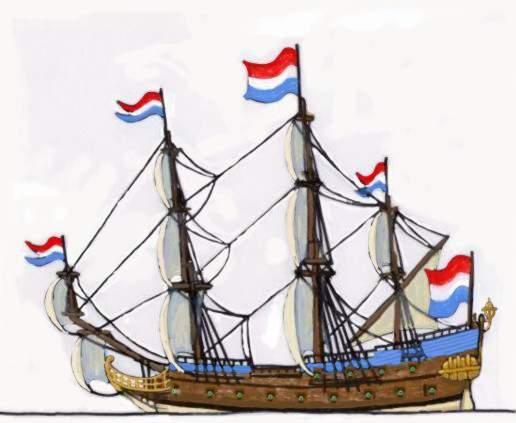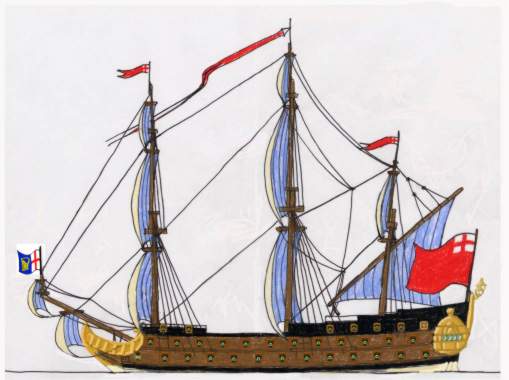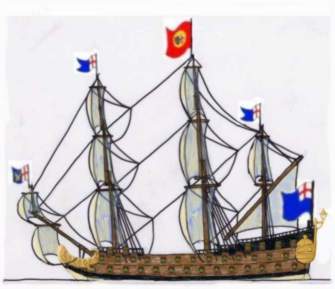Earlier, this evening, I was translating page 211 from Vol. V of Schetsen uit de geschiedenis van ons zeewezen, by Dr. Johan E. Elias. I was focused on this page, as I wanted to see if I might find more information that might resolve the name of Captain van de Werff's ship.
From that and The First Dutch War, Vol. IV, p.323, all we can say is that Captain van de Werff was employed by the Rotterdam Chamber of the VOC (the Verenigde Oost-Indische Compagnie). From that source, we know that the date he set sail to rendezvous with Witte de With's squadron, at sea, was 17 April 1653 (new style).
Perhaps the worst source to use would be Vol. I of The Paintings of the Willem van de Veldes. It pains me to say this, but the text from pages 15 to 19 is filled with errors. It is sad to say, because it was written by the late M. S. Robinson, Frank Fox's friend. As I understand the situation, Mr. Robinson was a great help to Frank Fox in preparing Frank's first book, Great Ships: the battlefleet of King Charles II. Frank is probably the leading authority on van de Velde drawings, now that Mr. Robinson is no longer living.
An example of the sort of problems that exist can be found on page 16. Thre, two of the ships listed at the bottom of the first column are: Jonas in the Walvisch (sic) and Ruiter. In reality, there were two ships involved with the Jonas en de Walvisch (the correct spelling used by Haverkorn van Rijswijk). One, the Jonas was a 30-gun ship commanded by Joris Colerij. The Jonas belonged to the Amsterdam Admiralty. The other was the Walvisch, also a 30-gun ship. She was commanded by Abraham Verleth, and had been hired by the Amsterdam Directors. Her crew was 110 men.
Worse yet is the other ship named, the Ruiter. I suspect that this was a reference to the Gewapende Ruiter. She was a Portuguese prize that was seized by the English, while returning from Brazil in June 1652. It is a mystery why she would be listed, except that the answer can be found in the horrible book by Carl Ballhausen, on page 617, in the Dutch list for the Battle of Scheveningen. Captain Schaeff is listed along with a ship, Huis van Nassau. Captain Boëtius Schaeff commanded the Gewapende Ruiter, at the time of her capture. In 1653, he commanded the Amsterdam ship, the Hoop (which is otherwise unknown). The only thing wrong with including him at Scheveningen is that he was killed at the Battle of the Gabbard, in June 1653.
Perhaps the culprit is Pieter Haverkorn van Rijswijk, writing in Oud Holland, Vol. 17, in 1899. He also lists a ship, the Rode Leeuw, which I happen to know was commanded by Reynst Corneliszoon Sevenhuysen. The problem with this ship name is that it was paid off after the Battle of the Gabbard, and Captain Sevenhuysen and his crew took over the new ship, the Mars.
There are even more atrocities committed here by Mr. Robinson, but I hope that I have made my point. I am trying to decide whether to list more problems or give up. The point is that you can't trust published sources, as they are often wrong. You need to have read all the published sources, and work at resolving the contradictions. I have found that Dr. Elias' work, the Schetsen 6-volume set is excellent. Short of having access to manuscripts from the Nationaal Archief in Den Haag, Schetsen will be extremely helpful.
You can't ignore the Navy Record Society 6-volume set, The First Dutch War, as you will find the greatest amount of Dutch ship information of any published source.
I'm afraid that Vreugdenhil's book, Vreugdenhil, A., Ships of the United Netherlands, 1648-1702, Society for Nautical Research, London, 1938, is a disappointment. There certainly is a wealth of information there. The problem is that it is filled with errors and omissions.



